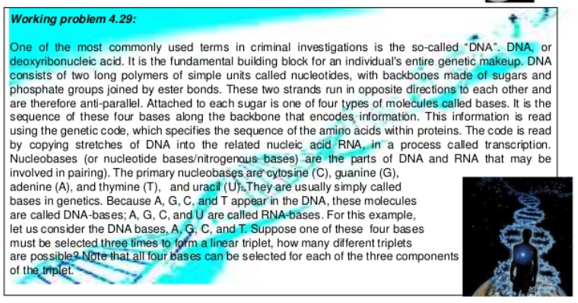One of the most commonly used terms in criminal investigations is the so-called "DNA". DNA, or deoxyribonucleic acid. It is the fundamental building block for an individual's entire genetic makeup. DNA consists of two long polymers of simple units called nucleotides, with backbones made of sugars and phosphate groups joined by ester bonds. These two strands run in opposite directions to each other and are therefore anti-parallel. Áttached to each sugar is one of four types of molecules called bases. It is the sequence of these four bases along the backbone that encodes information. This information is read using the genetic code, which specifies the sequence of the amino acids within proteins. The code is read by copying stretches of DNA into the related nucleic acid RNA, in a process caled transcription. Nucleobases (or nucleotide bases/nitrogenous bases) are the parts of DNA and RNA that may be involved in pairing). The primary nucleobasęs are cytosine (C), guanine (G), adenine (A), and thymine (T), and uracil (U).They are usually simply called bases in genetics. Because A, G, C, and T appear in the DNA, these molecules are called DNA-bases; A, G, C, and U are called RNA-bases. For this example, let us consider the DNA bases, A, G. C, and T. Suppose one of these four bases must be selected three times to form a linear triplet, how many different triplets are possible3 Note that all four bases can be selected for each of the three components of the plet
One of the most commonly used terms in criminal investigations is the so-called "DNA". DNA, or deoxyribonucleic acid. It is the fundamental building block for an individual's entire genetic makeup. DNA consists of two long polymers of simple units called nucleotides, with backbones made of sugars and phosphate groups joined by ester bonds. These two strands run in opposite directions to each other and are therefore anti-parallel. Áttached to each sugar is one of four types of molecules called bases. It is the sequence of these four bases along the backbone that encodes information. This information is read using the genetic code, which specifies the sequence of the amino acids within proteins. The code is read by copying stretches of DNA into the related nucleic acid RNA, in a process caled transcription. Nucleobases (or nucleotide bases/nitrogenous bases) are the parts of DNA and RNA that may be involved in pairing). The primary nucleobasęs are cytosine (C), guanine (G), adenine (A), and thymine (T), and uracil (U).They are usually simply called bases in genetics. Because A, G, C, and T appear in the DNA, these molecules are called DNA-bases; A, G, C, and U are called RNA-bases. For this example, let us consider the DNA bases, A, G. C, and T. Suppose one of these four bases must be selected three times to form a linear triplet, how many different triplets are possible3 Note that all four bases can be selected for each of the three components of the plet
Biochemistry
6th Edition
ISBN:9781305577206
Author:Reginald H. Garrett, Charles M. Grisham
Publisher:Reginald H. Garrett, Charles M. Grisham
Chapter6: Proteins: Secondary, Tertiary, And Quaternary Structure
Section: Chapter Questions
Problem 17P: Answers to all problems are at the end of this book. Detailed solutions are available in the Student...
Related questions
Question
Answer carefully and show your complete solution

Transcribed Image Text:Working problem 4.29:
One of the most commonly used terms in criminal investigations is the so-called "DNA". DNA, or
deoxyribonucleic acid. It is the fundamental building block for an individual's entire genetic makeup. DNA
consists of two long polymers of simple units called nucleotides, with backbones made of sugars and
phosphate groups jained by ester bonds. These two strands run in opposite directions to each other and
are therefore anti-parallel. Attached to each sugar is one of four types of molecules called bases. It is the
sequence of these four bases along the backbone that encodes information. This information is read
using the genetic code, which specifies the sequence of the amino acids within proteins. The code is read
by copying stretches of DNA into the related nucleic acid RNA, in a process caled transcription.
Nucleobases (or nucleotide bases/nitrogenous bases) are the parts of DNA and RNA that may be
involved in pairing). The primary nucleobases are cytosine (C), guanine (G),
adenine (A), and thymine (T), and uracil (Uj.They are usually simply called
bases in genetics. Because A, G, C, and T appear in the DNA, these molecules
are called DNA-bases; A, G, C, and U are called RNA-bases. For this example,
let us consider the DNA bases, A, G. C, and T. Suppose one of these four bases
must be selected three times to form a linear triplet, how many different triplets
are possible Note that all four bases can be selected for each of the three components
of the tplet
Expert Solution
This question has been solved!
Explore an expertly crafted, step-by-step solution for a thorough understanding of key concepts.
Step by step
Solved in 2 steps

Knowledge Booster
Learn more about
Need a deep-dive on the concept behind this application? Look no further. Learn more about this topic, biology and related others by exploring similar questions and additional content below.Recommended textbooks for you

Biochemistry
Biochemistry
ISBN:
9781305577206
Author:
Reginald H. Garrett, Charles M. Grisham
Publisher:
Cengage Learning


Biochemistry
Biochemistry
ISBN:
9781305577206
Author:
Reginald H. Garrett, Charles M. Grisham
Publisher:
Cengage Learning
